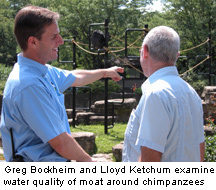
The chimpanzees and the new long-horned Ankole cattle at South Bends Potawatomi Zoo dont know this, but the quality of the water surrounding their habitats has improved, thanks to the work of Notre Dame civil engineering students.p. As chimpanzees jump, beat their chests and toss their dried snack pellets at zoo guestsa trick that amuses the guests as much as the animalszoo director Greg Bockheim explains the problem of algae accumulation that had persisted in the moats around these exhibits. The studentssolution included the strategic use of barley straw as a kind of water purifier.p. The water improvement initiative is just one of the service learning projects undertaken at the zoo by students of Lloyd Ketchum, associate professor of civil engineering. A walk-through South America exhibit is also in the works.p. Ketchum has led students into service learning experiences since 1989, when he joined the City of Elkhart on a project that transformed a municipal dump into an environmental park. His students also have worked on projects at Camp Eberhart, a YMCA facility located in southwest Michigan, not far from campus.p. But a small urban zoo, he says, provides civil engineering students with a surprising myriad of planning challenges. Exhibits of pythons, bats, kookaburras, leopards, camels, wallabies, white-nape cranes, bison, lions, tigers and red pandas camouflage what are essentially the needs of a small city. There are transportation challenges, from the installation and maintenance of pedestrian walkways to the zoos plans later this year to install a small train. Theres the challengeapproached by computer engineering studentsof how to best track visitors, or how to map the zoos utilities. There are roadways to maintain and water usage issues that address conservation and quality.p. Planning the South America exhibit represents a many-layered experience. It requires the creation of an environment to be enjoyed by humans, but one that will also transfer a number of animals from glassed-in indoor cages to an outdoor life among trees. Many of the inhabitants were bred and raised in zoos, not in the wild. Their adjustment to the new environment will include living with species their ancestors cohabitated with, but they have not.p. This year the engineering students are working with another group of Notre Dame students led by Agustin Fuentes, associate professor of anthropology and a primate specialist. As has happened with the engineering students, anthropology undergraduates hope to develop a long-term association with the zoo. Plans for the South America exhibit include a classroom space for students of all ages.p. “For Notre Dame students, this is an especially important opportunity because they can engage in cutting-edge behavioral and physiological data collection and analyses in their own backyard, and be involved in the creation of learning tools for the areas grade school and high school students,” Fuentes says.p. Last spring, as engineering students considered issues of habitat construction, the anthropology students studied the behavior of the habitats future residents, like the cotton-top tamarin.p. Cotton-top tamarins, says Fuentes, exhibit high degrees of social cooperation with all members of the family, and their waste can be examined for physiological data.p. “Correlating behavior and physiological state in such a cooperative species can offer insight to the evolution of family patterns and mutualistic assistance among relatives,” Fuentes says.p. The cross-disciplinary collaboration has already led to an upgrade of the tamarinscurrent environment. An intricate weave of vines has been built above existing small trees and limbs, providing a new location for feeding.p. Tamarins naturally take up residence at the central point of trees, rarely touching the ground. The upgraded habitat will help the tamarins transition to the new walk-through environment, where the area beneath the trees will belong primarily to visitors.p. Students on this project may someday constitute the rare alumni constituent that must visit the zoo and Notre Dame Stadium on home football weekends. But these projects will lend more to posterity than a family-friendly visitors stop.p. The data the anthropology students can collect and the experience of moving animals from an indoor space to a walk-through habitat will provide information about animal species that can and will be shared with zoos across the country, Bockheim says. It also will provide insight for zoologists attempting to reintroduce species to the wild.p.
TopicID: 6465